|
|
|
|
|
|
|
We Remember the SHTETLS!
|
|
|
|
|
|
|
The Association of Next Generation Polish Jewry
![]()
C O N G R A T U L A T I O N S!
September 2003: The Association has moved to its new web site at:
![]()
|
The Association of Next Generation Polish Jewry 4 Kvutzat L"G St. |
Our sincere thanks to Liat Uriel for her contribution to this web site!
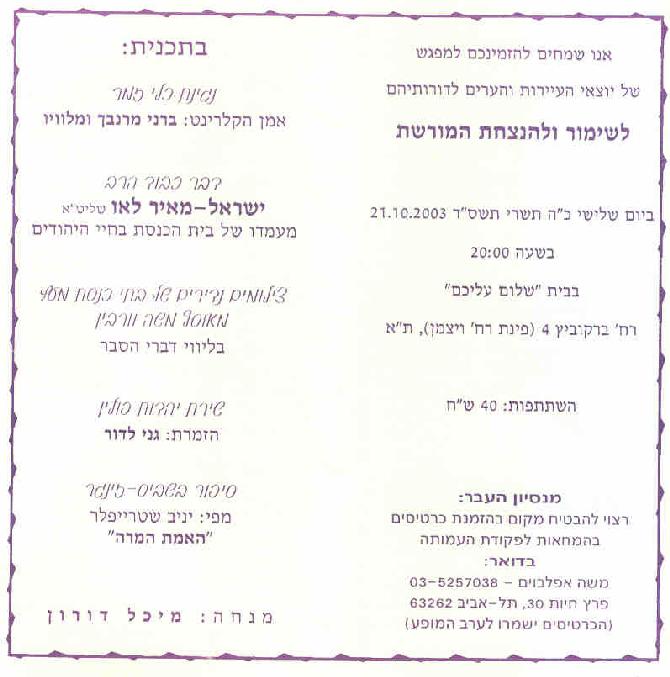
![]()
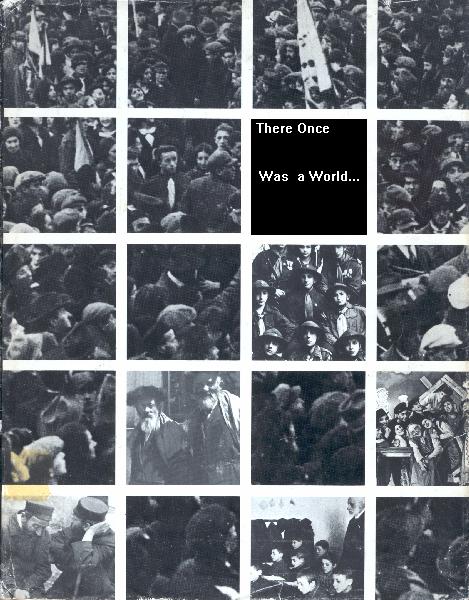
I
n 1996, because of the advancing age of the organization's members, a number of representatives of the next generation of former townspeople were invited for the first time to assist in the activities of the umbrella organization.I
n late 1998, with the help of donations and support from the umbrella organization, a non-profit organization known as "The Association of Next Generation Polish Jewry" was founded. The organization is registered under the number 3-918-032-58.Aims of the Association:
To preserve the memory and perpetuate the heritage of Polish Jewry through all its generations; to organize activities and gatherings for former residents of Poland; to propagate the heritage of Polish Jewry orally, in the printed media and through various other technological means; and to bring all aspects of the Polish Jewish heritage to the knowledge of the general public.Commemoration and Perpetuation Activities:
These will continue to be held in the framework of the associations of former townspeople.Friends of the Non-Profit Organization:
Former townspeople from throughout Poland who have expressed their identification with the aims of the organization and have sent in their details in order to be included on the newsletter mailing list and to receive invitations to annual cultural gatherings.Donors:
All those who have contributed to the organization and assisted in its establishment. All activities are voluntary.Active Members
: Thirteen members meet once a month to discuss issues, make decisions on various activities and see them through to implementation.Committee Members:
Michal Doron (Chairperson), Israel Gottlieb and Rina Libel are authorized signatories on the bank account.Control Committee:
Bat-Ami Goldstein, Hanna Granot and Yona Makel.Activity Frameworks:
Newsletter, cultural events and web site.T
he members aim to expand and intensify the activities of the organization."Heritage"
|
Michal Doron |
|
|
Yehuda Chamiel |
|
|
Arie Barnea |
|
|
Rina Libel |
|
|
Leopold Stacz |
|
|
Makow Mazowiecki, Poland, a Town & a Mother of Israel - the Life of the Community |
Mordechai Ciechanower |
|
Dawid Fiszrung |
|
|
What Brought Me to the Israeli Association of Successor Generation Townspeople in Poland |
Rina Libel |
|
Malka Harel & Silvia Avital ne'e Dorfman |
|
|
Ziva Cohen |
|
|
Chana Granot ne'e Perlmutter |
|
|
Arie Buchner (contributed by Michal Doron) |
It Has Finally Happened...

T
he Bulletin of the Association of Next Generation Polish Jewry has come out in print. Little by little, people who feel a link to their parents' past that is no more have begun to gather together and to devote a little corner to it in their lives. The articles appearing here are the result of a joint planning effort by these people and they are certain that many more will want to participate in this project devoted to their heritage.Michal Doron, Chairperson email: michal52 "at" bezeqint.net (replace "at by @ - to avoid spam)
![]()
I
t has become a tradition with us "people of the towns" to get together every year and experience something of past times, meet with friends, recall and reminisce, sing old songs and savor the past of all these towns that appear in the list on the wall. Each name tells the story of a full and exciting life, of rabbis, shohets, mohels, cantors, teachers, schoolchildren, dreaming and ambitious youth, rich men, poor men, Hassidim and Mitnagdim, Bundists and Zionists, romanticists and actors, beggars and fishermen, traders and idlers, and others. In coming here today, the people bring everything that was in them: the house, parents, families, institutions, synagogues, shtiebelach, schools, political parties, yeshivas, day-to-day life. Sabbath eve, with mothers lighting the candles, their faces aglow as they say the blessing on them. Sabbath and festival songs emanating from each window and open door, each in its own style. Weddings and other activities of all sorts. All these memories bind us and envelop us as we sit together. With all the pain that accompanies the great loss, we the survivors can look on in satisfaction at the fact that we have used our lives that were so spared to do much for our country, our nation and ourselves. We have raised new generations imbibed with national pride. Our faith and might have helped us to fight and liberate our country from a foreign yoke and establish a Jewish state. We have built cities, industries and a strong army to fight our enemies, who have still not relinquished the idea of exterminating us. Although we are not living in the best of times, we shall, as always, not despair and shall not yield until we are victoriousT
o you, the Successor Generation, I have a request to make. We are growing old, we are weary. Take the precious heritage that previous generations have bequeathed you - the love of your fellow man, whoever he may be, the desire to help others, the rich culture, the songs, the poems, the noble aspirations for a better tomorrow. Take up this cause, carry on the tradition - and may you succeedYehuda Chamiel, Chairman, Umbrella Organization
![]()
Poland as a Model to the Whole Nation
I
t was with great excitement that I learned about the important project that you have taken upon yourselves, and by so doing answer a painful question that many Holocaust survivors have locked in their hearts: What will happen to our memories of life and death after we are gone? Impressive second generation groups have sprung up in Israel recently to honor their parents and to participate together with them in meetings commemcommunities that were wiped out. Your organization takes this one step further bundertaking to preserve the memory for future generations.W
hy are we concerned only with Poland when the Jewish Diaspora has reached the four corners of the?H
ere are some answers to this question: - You and I would be glad if former residof Romania, YugoslaviaMorocco were to follow in our footsteps, whether to commemorate the Holocaust in particular or preserve the heritage of our grandfathers in general.O
ur commitment stems from honoring our parents and from the special bond we feel with their community. There is a difference between the communities of Poland and others, both in size - at least three and a quarter million on the eve of World War II - as well as the extent of the damage sustained at the hands of the Nazis and their collaborators: of the Jews who lived in Poland in 1939 and of those who remained after the great escape to Russia, over 90% were murdered. In addition, all six death camps were built and operated on Polish soil, absorbing millions of Jews from other communities on their last journey. Since the community of former Polish residents is such a prominent one, perhaps it can serve as a model for others: just as we are dedicated to perpetuating the memory of our families and communities, so might others follow suit in honoring their families and communities. Thus dedication will join dedication, effort join effort, and love join love to preserve the national heritage and hand it down from generation to generation.Arie Barnea, Principal, Gymnasium Herzliya
![]()
T
he heritage of fathers and mothers. The heritage of grandfathers and grandmothers. Customs and culture passed down to us from previous generations.W
e, the Successor Generation of former Polish Jewish residents and survivors, as well as of those who could be saved but perished in the Holocaust, have decided that we do not want to lose all the spiritual beauty that has been left to us by our families, writers and poets.D
espite the hard day-to-day existence that was eked out in the towns of Poland, there was a certain beauty, which has been handed down to us in both verbal and written form. We have inherited many positive customs from that period as well as a great deal of humor, a product of the tribulations, which has been passed on from generation to generation and which has helped us to stand firm in the face of difficulty. We now inhabit our own homeland, and once again we are going through a difficult period. However, by virtue of our heritage we shall stand resolute, we shall overcome and forge ahead, firm in the hope that we shall not forget the heritage of our fathers and pass it on in turn to our children.Rina Leibel (ne'e Chrzanower-Halbfinger) Active Member, Association of Next Generation
![]()
Three Towns

![]()
Makow Mazowiecki, Poland, a Town & a Mother of Israel- the Life of the Community
(Click each image for the Hebrew)
|
|
|||||||||
|
|
|||||||||
The Location & Structure of the Town
M
akov-Mazowiecki is a small town in Warsaw District. The town is located 95 km north of Warsaw and 55 km south of East Prussia (Germany).The Transportation to the Town and its Outskirts
A
slow bus belonging to P.K.P. - Polska Komunikacja Przemystowa (Industrial Polish Transportation) reached the town twice a day, once in the morning and once in the evening, and continued north. The trip took about three hours in each direction and the journey cost 5 zloty. Carriages drawn by four horses left the town in the evening and reached Warsaw during the early hours of the morning, after which it returned. The trip took about nine hours in each direction and the journey cost about 3.5 zloty. A travelling salesman could load all his merchandise on the carriage and also travel at a reduced rateMr. Gottleiser owned a private car, which he used in emergencies to transport people - for example, to the hospital in WarsawThere were fairs in the area to which people travelled in horse-drawn wagons. The towns of Ostrolenka, Mlawa and Ciechanow had a railway.The Jewish Community and its Institutions
T
he community traces its origins to the 14th century. During various periods, the Jews outnumbered the Christians. On the eve of World War II, the number of Jews was close to 5,000. Among its institutions were the Great Synagogue, which was built in the 18th century and renovated in the 19th century, Makow Yeshiva, the community center, a mikve, two Batei Midrash, the older of which was burned down in 1934 and then rebuilt, prayer halls belonging to the Alexander, Gur and Amanshov Hassidim. The associations of Linat Zedek (for people with no families, the infirm or the handicapped who needed help and who slept there), Gmilut Hasadim and Bikur Holim. There were two cemeteries, which were destroyed during World War II.Sources of Livelihood
A
s in most of the Jewish communities in Poland, the principal sources of livelihood were the trades, with shoemakers, tailors, furriers, milliners, carpenters and tinsmiths working side by side with shop owners, brewers, and sugar plant workers. There were two flour mills, two soap factories, two knitwear plants and two factories manufacturing tziziot. Most of the shops in the market s(Rynek) belonged to Jews (the first floor housed the shops and the sf, theown). and Friday were the weekly market days.Means of Health Care
T
here was a licensed male nurse in the town (Felczer) anmethoof healing were lecupping glasses. In cases where he did not succeed in curing the patient, he would referhim with a letter to oWarsaw, mainly the latter. There was also a Jewish dentist and a midwife.The Institutions of Culture and Education
U
ntil World War I, there were heders for religious studies as well as an elementary school, where the medium of instruction was Russian. Children of haredi families who did not learn in school studied privately: Yiddish, Polish and arithmetic. After the town was liberated by the Poles, the school was expanded. The language of instruction was Polish, and the subjects studied included Bible and Jewish history. In 1917 a Jewish kindergarten was opened and in 1918 a Polish high school was established in the town. The Jewish children studied in Yavne school (which was established during the period 1928-1930), in the haredi school, the elementary school and the yeshiva belonging to the Newerdyk chain. There were also knitting courses in ORT.T
he elementary school had seven classes and those who completed them went on to high school.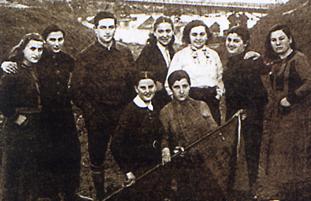
Youngsters from Rozan
M
ost of the Jews did not attend them since studies were also held on Shabbat. More than 90% of the Jews were traditional. The wealthy Jews, who were few in number, went to Mlawa, where there was a Jewish high school. Some travelled to faraway Warsaw to study in the Jewish high school there. Some went to Pultusk to attend the school of commerce. Others studied with private tutors or found work.T
he town had five libraries, located in the Polish high school, the Bund named after I.L. Peretz, "Shalom Aleichem," the haredi school, and Yavne school.The Culture of Leisure
L
eisure time was spent by the youth and some of the adults in reading, e.g. textbooks and encyclopedias. The observant Jews read religious books. There were some who read the classical literature popular at the time, such as Dostoevsky, Tolstoy, Pushkin, Adam Mitzkevitz, Yiddish literature by Shalom Aleichem, Mendele Mocher Hasefarim, I.L. Peretz, Bialik, Tchernikhovsky, and others.N
ewspapers arrived once or twice a week from Warsaw, Mlawa, Ciechanow and Pultusk. Weeklies were the most popular. In 1939 a weekly newspaper began to be published in the town.T
he Bund movement began its activities at the beginning of the 20th century. After the war, in 1918, branches of the Zionist movement, such as Poale Zion Smol, Hamizrahi, Tze'irei Mizrahi, Hahalutz and the youth movement Pirhei Zion, made their appearance.T
hese were followed by Hashomer Hatza'ir, Hahlutz Hatza'ir, Beitar, Agudat Israel and Poale Agudat Israel. The Scout Movement (Hatzofim) was common to both Jews and non-Jews. The youth commonly took part in the various activities. On Saturdays youngsters would go on excursions in groups to the forests while they would also wander around the market square (Rynek).S
ports in which they took an interest were football and table tennis. Other activities were folk dancing, lectures and sing-alongs with songs from Eretz Israel, expressing the yearning to go to Israel. The Jews of the town were engaged in the collection of money for Keren Kayemet LeIsrael (at the end of the 1930s Golda Meir visited the town in order to encourage the collection of money).A
theater group from Vilna (Wylner Trupe) visited the town, putting on a number of shows. It arrived with artistes such as Josele Kolodny and Lola Furman. The town itself had an amateur Jewish theater that staged Jewish shows. Radios were owned by only a few families, although on the eve of World War II a large number of people could be found listening to them.Gramophones were also owned by a minority of families who enjoyed listening to music. There were klezmers who played at weddings and other functions.Personalities of Virtue
P
olish towns, both large and small, were the wellspring of famous personalities, their offspring and relatives. Makow itself boasted no small number: Admiral Hyman G. Rickover, the inventor of the submarine and builder of the atomic submarine for the US fleet; Nahum Sokolov, who lived and studied in the town's yeshiva and who married the daughter of Haim Segal, one of the town's wealthy residents; the relatives of Leon Blum, who was Prime Minister of France during the period 1936-1938, and who established the interim government up to the time of the elections for president after World War II, and who even had a house that he had inherited in the town; and David Azrieli, architect and builder of shopping malls in Israel, with worldwide business interests.Epilogue
P
eople will say that this is how it was in most towns in Poland. However, each town had its own uniqueness and this is what enriched community life throughout the years before it was prematurely cut short, adding layer after layer to the illustrious heritage of Polish Jewry.C
horzele was not a particularly large town near the border of Eastern Prussia before World War II, 27 km from the larger town of Prozanow and 130 km from the major city of Warsaw.A
ctivities among the Jewish youth of the town, which formed the minority relative to the Polish population, was varied. Most of the organized Jewish groups were, naturally, pioneer Zionists, prominent among which, in terms of numbers, were Gordonia, Hahalutz, Hahalutz Hatza'ir, Hashomer Hadati, Beitar and others. A particularly large center of activities was the Hall of Culture in the center of town, where various activities relating to Eretz Israel were held.O
ne evening in particular stands out in memory. Referred to in Yiddish as "Trojer Uwnt," it was organized by Gordonia and held in a side room in the Hall of Culture in commemoration of the five who fell in the Jerusalem hills and after whom the kibbutz Ma'aleh Hahamisha near Jerusalem is named. The evening was very impressive. A tombstone of sorts was constructed with the names of the fallen engraved on it, and memorial candles were lit. Tales of military heroism were read out, ending with the singing of Hebrew songs that had been learned. Many youths were present, even those who were not members of Gordonia, as well as older people who had come for other activities, but who were attracted by the event. The Hall of Culture also contained a library with thousands of books, most of them of course in Yiddish, our lingua franca, but also a large number in Hebrew, which we learned in the framework of special evening lessons. The borrowing of books was very common amongst the youth as well as amongst the older folk, who took a great interest in world literature. The large hall also contained a ping-pong table for the members. The youth also had various hobbies, the most popular of which was the collection and exchange of stamps from all over the world. The above is just a small sample of the activities of the Jewish youth in the town of Chorzele.Contributed by Israel Gotlib, a descendent of Chorzele and active member of the Association
.What Brought Me to the Association of Next Generation Polish Jewry
T
he years go by quickly. We are busy. We are forever trying to fit everything in and achieve things that are not always achievable. Slowly but surely, events from the past are forgotten, while others we do not to remember. The past of oldsters is of no interest to us and appears distant and different. Not always do our parents want to tell us about the past. When they grow old we sometimes accompany them to various gathein order to please them. Then comes the difficult day when we lose them suddenly, together with the pain and sorrow, we feel a void. We experienced our own child, exthe childhand growing up of ourchildr, but what do we know about the childhood of our parents? What did the cities and towns they grew up ilook like?At what dthey play, what were they active in, what did they believe in, whom did they admire? And then we wonder, Why didn't we ask? Why were we not interested and why didn't they tell us anything? And so I started investigating.I
started going to memorial services and meetings of the "people of the towns" to which I had once accompanied my parents, trying to extract details and stories about their places of birth, their lives, the hardships and joys that were their lot, and the culture and values they were nurtured on. I grew up and was educated in Israel according to concepts that were instilled in our Diaspora in Poland, but I miss the "Mama Loshen," the stories and jokes that had taken root "there" and even the superstitions that had so amused me in my youth.A
s a result, I was happy to hear that the Next Generation Association had been formed and I joined it as an active member. We sit at meetings, work out problems and search for ways to bridge the gap between the cities and towns of Poland - in the past, present and future - and our own current lives. How does one preserve all that beauty so as not to lose it?I
n conclusion, let me say that we want you with us. Please, join us and share with us your thoughts regarding the concept of the Next Generation.W
e will be glad to receive advice, ideas and lots of cooperation.
Contributed by Malka Harel & Silvia Avital ne'e Dorfman
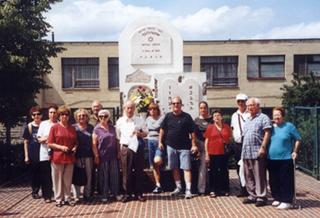
I
n July 2001 a group comprising former residents of Ostrolenka and environs as well as Next Generation members organized a visit to the Ostrolenka area. The date of the trip was scheduled to coincide with the publication of a book in Polish on the Jewish community of Ostrolenka. The visit was initiated and organized by Mr. Yehuda Hamiel, and we were accompanied by Dr. Dresner, who had conceived of and was responsible for translation of the book. A ceremony was held in honor of the book's publication, with the Mayor of Ostrolenka, the Press Attach? of the Israel Embassy in Poland, and Polish representatives who had supported the translation effort in attendance. To us, as next generation members, the visit to Ostrolenka was a difficult experience and charged with emotion. We wandered around the town streets for hours and group members pointed out various houses where the families of the participants used to live, trying to describe what their birthplace was once like. We walked around in a daze. We tried to imagine our relatives going about their daily lives in these places. We saw the place where the Jewish elementary school used to be, the state school, the place where the synagogue stood, the community committee building, the mikve, the buildings where the younger theater lovers of the Jewish community used to gather. We arrived at a spot where the town square used to be situated; of all the houses around the square, most of which were Jewish, nothing remained. We reached the banks of the Narew River, which passed through Ostrolenka and of which we had heard stories from our dear departed father, Zvi Dorfman. Near it, on the fisherman's road, were the fish traders, including those from our own family. We did not find any trace of the home that had belonged to our family, Dorfman. One of the group members was lucky - he located the home of his grandfather, and the occupant allowed him to enter and have a look around. This was perhaps the most thrilling part of the visit here, allowing one to get a sense of the past, even if only for a moment. We ended our tour by placing a wreath on and praying kaddish near the impressive gravestone erected by former Ostrolenka residents in memory of all those who had perished. The pain we felt during the visit was for what once had been and is no more, for the fact that there is no mention of the active life in the large Jewish community that had existed in the place. There is no sign of or information on the Jewish life that was cut short here, not even in the dossier that we received as a gift from the mayor describing the history of the town and district in glowing terms.L
et us end with a quotation from the speech given by Mr. Yehuda Hamiel: "Before you stands a member of the Jewish people, one who was snatched from the deathly inferno, born in the town of Ostrolenka and speaking to you of a book on the Jewish community of Ostrolenka that is no more. The book is a commemoration and a monument to the thousands of Jews from all walks of community life, to its institutions and to its life style... a Jewish community amongst other communities in Poland that had flourished for hundreds of years until the Grim Reaper descended on it and extinguished every memory, all the splendor of the Jewish people."W
e thank Yehuda Hamiel for organizing the tour and for giving us the privilege of visiting the town in which our families were born, and to hear facts and gain impressions and experiences firsthand.![]()
The Jewish Woman in Poland

T
he principal role of the Jewish woman in Poland was summed up in the term "Yiddishe Mama" - a woman devoted to her family, a faithful wife and a loving, caring mother. Her traits typified the woman in her biological role as a mother, child bearer, and propagator of the family and the family name. Such a woman is described at times as being helpless and fragile, and dependent on her husband; in most cases, however, she is depicted as courageous, resourceful and one who is able to come face to face with harsh realities. From the end of the 18th century and into the 19th century, a change took place in the status of women in general, and Jewish women in particular. This change occurred against the backdrop of the industrial age, the development of a bourgeois society, the spread of education, especially in the big cities such as Warsaw and Krakow (where intellectuals proclaimed "Women's Emancipation!"), as well as the appearance of feminist movements that advocated women's liberation.T
here were a number of reasons for the change in women's status:W
hen women started to constitute a link in the industrial chain, with all the professional demands that this entailed, claims began to be made for training programs, which at times took the woman away from the home and created a new status for her.T
he social security she acquired by being a woman working away from home brought her closer to the man's world. The individualism that developed in the 19th century strove to recognize women's self-esteem and independence and their entitlement to equal rights in human society. This approach, in addititon to the acquisition of a general education, found women becoming actresses, singers, artistes, musicians, agronomists, factory laborers, waitresses, marketplace traders, public institution workers and housewives. These professions were a supplement to her traditional role as mother, daughter and wife.T
he economic and social condition of women influenced their level of individualism, which found expression in their status. The richer they were and the higher their social and economic rank, the more they were able to benefit from women's individualism: women could acquire a profession and realize the potential inherent in them. In the lower classes, the economic pressures slowed down the entiprocess, while the democratization of society also had an effect on wom's status. The demand for social equality brought about practicaresults.In large families anequality was achieved betthe parin the framework of the nuclear family. In the state and in society a democratic struggle was taking place fpolitand legal of women, in order to give them the vote on an equal footing with men.
T
he town of my birth, Grajewo. On the German border, 60 km from Bialystok.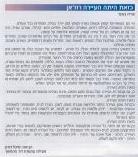
W
ho are the ones that are left? A small group of people in Israel and an even smaller group in the Diaspora, scattered throughout the world. The Rozan community, which numbered about three thousand souls, has been exterminated and wiped out. A community that, despite its poverty, had a charm of its own, the charm of a small town, energetic and fighting for its existence.F
or truly, what did it lack? It had Mitnagdim and Hassidim affiliated with different rabbis, merchants and artisans, parties of every political hue, youth movements, libraries and drama circles, balls and plays, sports and excursions. Each event in the town became common property, each event, the collective happening of the entire public. Who amongst us does not remember the wedding evenings? Nearly everyone waited in anticipation for the chupa, as though it was the chupa of their own relatives or families. And at the chupa one would meet all the youth of the town.Who amongst us will not remember the plays? The play would start at ten o'clock at night, and at times even at eleven o'clock, when elsewhere in the big wide world it had already ended. The play continued for a long time, nearly double the time required, because the audience heard the text twice - once from the prompter and once from the actor, the artiste. And nobody resented the fact that the actor did not know his lines by heart. When the play was over, dawn was already breaking and there was no point in going back home to sleep. So we talked or strolled down the Pultusk road until sunup, until the full light of morning.
S
uch was the town.Y
es, the town even had thefts, but thefts of a different kind - theft of books from the library, "cultural" thefts unbeknownst to other towns and cities in the area.S
uch was the town.A
nd when a tragedy befell the town, the news was whispered from neighbor to neighbor, from house to house, from family to family, and the charitable women suddenly found themselves with their hands full. Help was needed, assistance must be rendered quickly. There was collecting and scrounging to do. And then one would see them soliciting help at people's doors like beggars, asking for anonymous donations in order to save a Jewish soul.S
uch was the town.A
nd on festivals the entire town preened itself. The children were washed and combed, dressed in their holiday finery, running around the synagogue and around the various shtiebelach. The entire town was dressed up for the festival. Such was the town. Was, and is no more. Was, and will never get to be seen again. Was, and has vanished from the world. Was, and will never rise again.
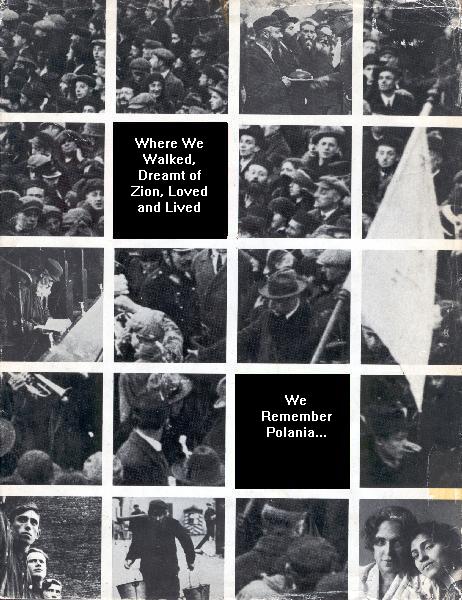
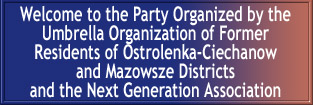
|
The annual event in 2003 will take place on October 21st, 2003. Cost is NIS 40.- only Tickets and Reservations: |
You may also send your request to join the Association by sending an email to Michal Doron michal52 "at" bezeqint.net (replace "at by @ - to avoid spam) or Ada Holtzman, :ada01 "at" netvision.net.il
Registration is free!
Contributions are Welcome!
You can send your application also by mail or fax, as per the following details:
|
The Association of Next Generation Polish Jewry |
Partial List of Lost Communities with an Internet Web Site
Belchatow | Bedzin -Ir Hametim | Bialystok | Czestochowa-Radomsko Area Research Group (Prof. Daniel Kazez's Web Site)| Chelm | Ciechanow (Ciechanow Research Group Web Page) | Czyzewo | The Jewish Cemetery of Czestochowa | Debica (Preker's Remembrance Page) | Giraltovce (Slovakia), Gabi Lana's Remembrance Page | http://internex.net.au/~fdobia/Golub Dobrzyn (Frank Dobia's Web Site) | Gombin (Gabin) - Parents' Hometown | Gostynin | Glowaczow | Glowno| The Jewish Cemetery of Grodzisk Mazowiecki | Hrubieszow | Janow Sokolski | Jedwabne | Kalisz (Sue Fifer's Web Page) | Kanczuga | Kiernozia | Kleczew | Konin | Korczyna (Translation of a Whole Yizkor Book in JewishGen)| Krasnosielc | Kurzelow| Kutno (Dariusz Marchewka's Web Page) | Lipno | Lodz Area Research Group (LARG) | Lodz and its Region | Remember Lodz (JewishGen Web Page) | Lodz Jewish Cemetery | Losice | Remembering the Jews of Lubaczow (Eva Floersheim's Web Page) | Lublin - To Tell... To Internalize... To Remember... (Lublin Organization Web Site) | Minsk Mazowiecki | Mlawa M.R.I. | Novy Jicin (Czechoslovakia) | Opoczno | Pabianice | Remember Pinsk (Nakhum Boneh's Memorial Web Page) | Plock - P.R.I. | Piotrków Trybunalski (JewishGen Web Page) | Radom | Radzilow (Jose Gutstein's Memorial Web Page) | Rozan | Sanniki | Sompolno | Stropkov (Czechoslovakia - Melody Amsel Page) | Suprasl | Szczuczyn (Jose Gutstein's Memorial Web Page) | Tomaszow Mazowiecki | Valasske Mezirici! (Czechoslovakia) | Warta | Wizna (Jose Gutstein's Memorial Web Page) | Wloszczowa | Wysokie Mazowiecki | Wyszogrod | Wyszkow | Zabludow (Bartman's Memorial Web Page) | Zabludow Yiskor Book: Translation Initiated and Coordinated by Tilford Bartman | Zakroczym | Zdunska Wola
The List of the Jewish Communities of Poland
JewishGen: The Home of Jewish Genealogy in the Internet
JewishGen: the Yizkor Book Database
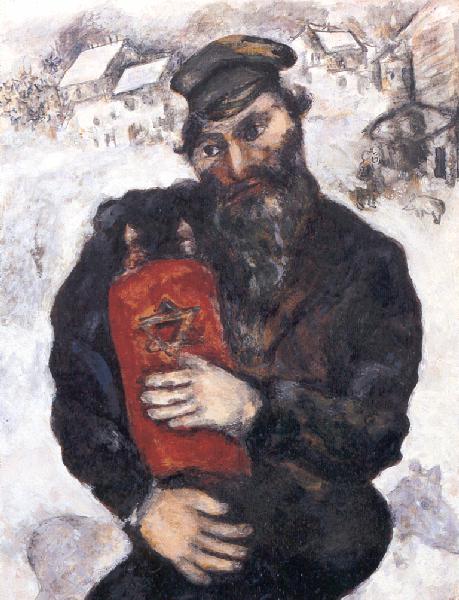
Marc Chagall: a Jew with Torah 1925
![]()
C O N G R A T U L A T I O N S!
September 2003: The Association has moved to its new web site at:
![]()
Last updated 9th October, 2003